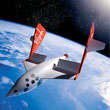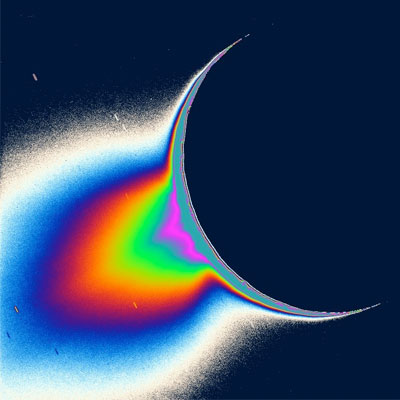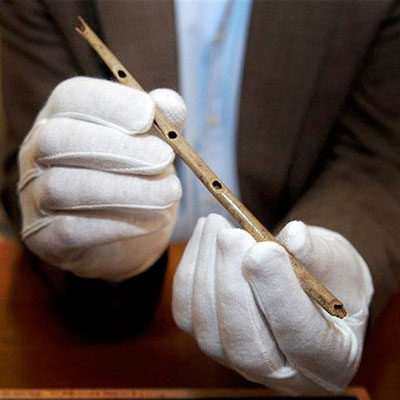 Welcome back to another exciting week of Science Friday! Today, explore the galaxy from the world’s first spaceport, see the salty plumes of Enceladus, power up at the world’s largest solar array, and sing along to the 35,000-year-old flute. All this and more plus your gadget of the week: Samsung’s flexible OLED passport!
Welcome back to another exciting week of Science Friday! Today, explore the galaxy from the world’s first spaceport, see the salty plumes of Enceladus, power up at the world’s largest solar array, and sing along to the 35,000-year-old flute. All this and more plus your gadget of the week: Samsung’s flexible OLED passport!
World’s First Galactic Spaceport Underway
Commercial space flight for the non-astronaut is becoming more and more common these days. Recently, Virgin Galactic announced that they have broken ground on the world’s first spaceport in New Mexico. SpacePort America will be the launching ground for SpaceShipTwo, the craft that will send you into space for a mere $200,000. Flights will last about 2.5 hours, and they include around 6 minutes of weightlessness. The company hopes to take flight in December, 2010, and more tan 250 people have already booked passage. See the video below for some visuals and check out the
SpacePortAmerica website.
Salty Plumes from Enceladus Suggest Life on Saturn’s Moon
It is not a knew theory that Enceladus, a moon of Saturn, may harbor a salty ocean beneath its icy surface. Recent data from NASA’s Cassini Mission (whose imaging team is lead by Star Trek science advisor Carolyn Porco) suggests that geysers from the moon may be fed by a salty ocean. The planet’s outer ring, or “E-ring,” is believed to be primarily supplied by giant geysers on Enceladus’s south polar region tossing out materials to a distance of three times the moon’s radius. Cassini’s cosmic dust analyzer has examined the composition of the material and found salt within it. This furthers the theory that the moon may be capable of supporting marine life. Check out CICLOPS.org for more info!

Salty plumes of Enceladus
World’s Largest Solar Array Planned for Saharan Desert
20 German solar companies are looking into installing the world’s largest solar array in the Sahara Desert, a place that certainly gets a lot of sun. In fact, the Sahara gets so much sun, that if only 0.3% of its area were used for a solar plant, it would power all of Europe. The plan for the array would be to build several solar complexes in politically stable countries across northern Africa. The entire project would take years to build and would cost an estimated $555 billion.

The solar array planned for the Saharan Desert
35,000-year-old Flute Discovered
This flute is the first musical instrument in the history of humankind—one of the first examples of technology—which has surprised everyone demonstrating that music already existed 35,000 years ago. It was made from the bone of a giant vulture during the Upper Paleolithic and was found in Ach Valley, in southern Germany. According to one study, it was capable of producing a note range similar to those of modern flutes.

The first musical instrument ever known
Gadget of the Week: Samsung’s Flexible OLED Passport
Samsung is now showing off this prototype ID card with a built-in flexible OLED display. The display is 2 inches and 240×320, showing a rotating head in 260k colors with a 10,000:1 contrast ratio. This product is a great way to show off what flexible OLED technology can do, and it is a neat look into what future travel may be like. Like something out of a science fiction movie, this thing doesn’t even need to be charged as it gets its power from an RF source wherever it is being scanned.
Video of the Week: Hybrid Heart
Scientists have created a “hybrid heart” using stem cell research, which would allow a stopped heart to start beating again. Hybrid hearts such as these could solve the transplant shortage and could lead to the growth of artificial organs in the future.
Image of the Week: Volcano seen from space
The International Space Station took a photo from space that shows a volcano in the earliest stage of its eruption. Taken as a huge plume of ash and steam billow skyward the image shows the impact of the shock wave spreading out in the atmosphere. Nasa says volcanologists are excited about the picture “because it captures several phenomena that occur during the earliest stages of an explosive volcanic eruption.”

Sarychev Peak on Matua Island
#FollowFriday
If you are on Twitter, you know there are plenty of amazing people out there tweeting away. And, many of them are scientists! Every Friday I’ll be bringing you a new list of great scientists and techies to follow on Twitter. This week…
- @LRO_NASA: NASA’s first step back to the moon! The Lunar Reconnaissance Orbiter is currently on its way to the moon. Follow along on its journey!
- @scifri: We make a science radio program heard on NPR and create science content for the web. Got ideas? Write us @scifri and tweet your questions during the show.
- @donttrythis: Adam Savage of Mythbusters. “Don’t try this at home!”
Science Quickies
Not enough science for you? Here’s a warp-speed look at some more science tid-bits that are worth a look.
- Buzz Aldrin says: Time to settle Mars
- Fake astronaut hit by solar flare
- Stoned wallabies make crop circles in poppy fields
TrekMovie’s Science Friday is an homage the the great NPR radio show Science Friday. Science Friday® is a registered service mark of ScienceFriday Inc.

1ST/// Really cool!
Cool! Spaceports, electronic passports and stoned wallabies, this science friday is the best
Wish I had 200K lying around to book a ticket on Virgin Galactic. I hope in my lifetime, it becomes affordable and I can see the Earth from space. That would be very, very cool.
I want one of those passports.
It reminds me visually of the hologram of Spock shown to Captain Robau.
But an ID card like that looks great !!!
The annual free ticket for a science student is a BRILLIANT idea. Worth tons more than $200k in goodwill.
I beleive the ship is called the V.S.S. Enterprise.
Just a note – the first two links under “Science Quickies” both point to the Buzz Aldrin story…
Great. A lunar probe that tweets. Does it also hit on underage iPhones on MySpace?
Love the flute story, but why no audio??? Is it as cool as Picard’s (fake) Ressikan flute?
Love the 3-D ID. I just renewed my driver’s license for 10 years, using the picture they took 5 years ago. Damn, I’m gonna look great at 56.
Also love the fact that we’re commercializing space. I think, though, that I’ll wait until I can go without mortgaging two of my kids.
Thanks, as always, Kayla!
Great round-up, Kayla!
The Saharan solar array is a natural. Looks like they’re using concentrated sunlight to heat up a something in the center, rather than photovoltaics. Good idea. I wonder how much trouble sandstorms will be.
We really need to send some life-seeking probes to places like Enceladus and Callisto.
Scott B. out.
I’d be intrigued to find out more about Enceladus. We HAVE to send a probe below the surface to see what’s there.
I had seen that volcano photo. It put me in mind of a view of the Narada’s drill descending to the planet’s surface.
That’s an awesome Volcano pic. Great round-up as usual, Kayla.
I have beef with the solar array in the Sahara. Will this just be exploiting African countries or will these host countries actually experience some development because of it? Granted, they will be using German expertise but will they hire any local labour and contribute to the local economy? Projects like these should be coupled with development agreements for the host nations – say, the companies agree to build some schools or install some irrigation systems as well. These people will have a $500 billion solar array in their backyard but no safe drinking water in their kitchen.
Does anyone else see where I am coming from?
There is undiscovered scientific treasures on Saturn’s moons.
I totally agree, Newman. History is packed with exploitation of the natural resources of poor countries by rich ones. I’m sure these days that a deal will be struck. Unfortunately, it will be the (almost certainly) corrupt and exploitative governments of the north African countries who will benefit, not the rank and file. It is the sad, sorry way of things.
Scott B. out.
No mention of the 16 year old infant? It’s a fascinating story, this little girl should be sixteen, but she’s not. She hasn’t aged a day since she was born. Stumps scientists everywhere.
Holy belching volcanos, Batman! Talk about cinema vertea, or rather, still vertea. What a shot! Already saved to My Pictures.
Still diggin that loveable Cassini and Enceledus.
I might only be a stoned wallaby, but I’m having a great time. }:-D>
As always, thanks for another great science round up! So many new advancements that I hadn’t heard about… Thanks for keeping me informed!